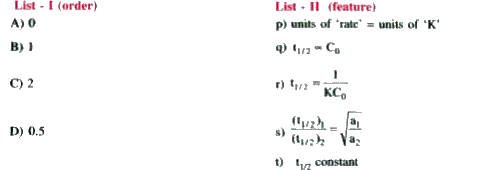Thallium (I) is oxidized Ce(IV) as follows:
Following are the elementary steps involved in the above reactionn
If rate then catalyst intermediate and rate determining step are respectivelySolution in Telugu
The correct Answer is:A, C
Constant
Intermediate 1st step
Topper's Solved these Questions
- CHEMICAL KINETICSBook:AAKASH SERIESChapter:CHEMICAL KINETICSExercise:LEVEL-II(LECTURE SHEET EXERCISE-II LINKED COMPREHENSION TYPE QUESTIONS)
Explore 9 Videos
- CHEMICAL KINETICSBook:AAKASH SERIESChapter:CHEMICAL KINETICSExercise:LEVEL-II(LECTURE SHEET EXERCISE-III MATCH THE FOLLOWING QUESTIONS)
Explore 3 Videos
- CHEMICAL KINETICSBook:AAKASH SERIESChapter:CHEMICAL KINETICSExercise:LEVEL-1 (EXERCISE -II ORDER, MOLECULARITY, HALF LIFE:)
Explore 34 Videos
- CHEMICAL KINETCSBook:AAKASH SERIESChapter:CHEMICAL KINETCSExercise:EXERCISE - 3.2
Explore 45 Videos
- CHEMICAL THERMODYNAMICSBook:AAKASH SERIESChapter:CHEMICAL THERMODYNAMICSExercise:Additional Practice Exercise
Explore 54 Videos
Similar Questions
A certain endothermic reaction: A→ Product, ΔH=+ve proceeds ina sequence of three elementary steps with the rate constant K1,K2 and K3 and each one having energy of activation E1,E2 and E3 respectively at 25∘C. The observed rate constannt for the reaction is equal to K3√K1K2.
A1,A2 and A3 are Arrhenius parameters respectively.
The observed energy of activation for the reaction is
View SolutionMatch the following columns

View SolutionSucrose decompose in acid solution into glucose and fructose according to the first order rate law, with t12=3.00 hours. What fraction of sample of sucrose remains after 8 hours ?
View SolutionDiscuss on the kinetic spontaneity of a chemical reaction. Is a slow reaction spontaneous? Why?
View SolutionWhich among the following is not an exact differential?
View SolutionThe EMF of the cell : Pt|Ce^(4+)(90%),Ce^(3+)(10%)| Normal calomel electrode is 1.464 V at 25^(@)C . Find the value of equilibrium constant of the reaction : 2Ce^(3+)+2H^(o+) rarr 2Ce^(4+)+H_(2) The electrode potential of the normal calomel electrode is +0.28V .
View SolutionFor the reaction : 2Ce4++Co→2Ce3++Co3+,E∘cell=1.89V, If E∘RP for Co2+/Co is −0.28V. Calculate of E∘RP for Ce4+/Ce3+.
View Solution2Ce^(4+) + Co rightarrow 2Ce^(3+) + Co^(2+), E_(cell)^(@) = 1.89V E_(Co^(2+)//Co)^(@) = -0.277V . Hence E_(Ce^(4+)//Ce^(3+))^(@) is
View Solution2Ce4++Co→2Ce3++Co2+,E∘cell=1.89V
यदि ECo2+1M/Co=−0.28V0, तब ECe4+1M 1M/Ce3+ ज्ञात करो ।
View SolutionIn a multistep chemical reaction, which elementary step is considered as the "rate determining step"?
View SolutionAccount for the following : (c) Ce^(+3) can be easily oxidized to Ce^(+4)
View Solutionनिम्न के इलेक्ट्रॉनिक विन्यास लिखिए-
(i)La3+ (ii) Gd3+ (iii) Eu2+ (iv) Ce4+ .
View SolutionCe3+ को सरलतापूर्वक Ce4+ में ऑक्सीकृत क्यों कर सकते हैं। (Ce का परमाणु क्रमांक-58)
View SolutionCalculate value of E∘Ce4+/Ce3+. IF E∘cell for the reaction, 2Ce4++Co→2Ce3++Co2+ is 1.89 V. If E∘Co/Co2+=−0.28V
View SolutionCe^(3+)সহজে Ce^(4+) - জারিত হয় কেন?
View Solution

